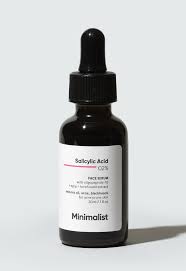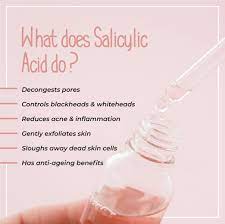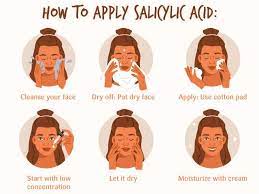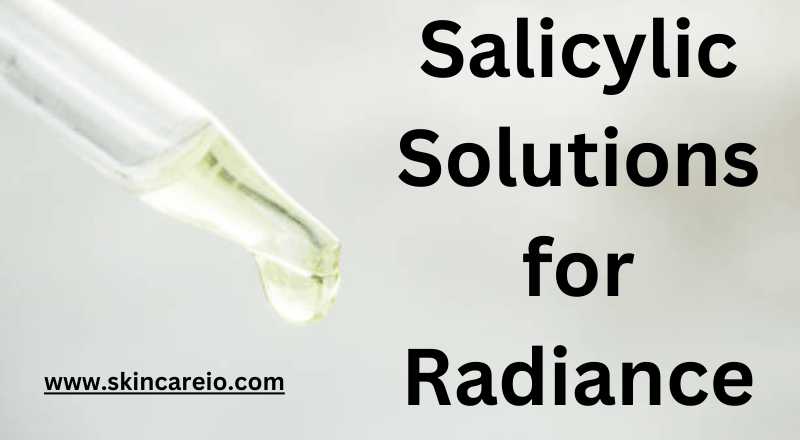Salicylic acid is a naturally occurring organic compound with a chemical formula C7H6O3. It was originally derived from the bark of willow trees, and its name is derived from “Salix,” the Latin name for willow. Generally, salicylic acid is a beta hydroxy acid (BHA) that is commonly used in skincare and dermatology for its exfoliating and anti-inflammatory properties. Now a-days salicylic acid is often synthesized for various applications, including medicinal and cosmetic uses.

Benefits of Salicylic acid
Salicylic acid is a beta hydroxy acid (BHA) with the ability to penetrate oil and exfoliate inside the pores. It helps to remove dead skin cells and debris, keeping pores clear and preventing acne breakouts. Salicylic acid is widely used to treat acne. It can help reduce the appearance of pimples, blackheads, and whiteheads by unclogging pores and preventing new acne lesions from forming. Salicylic acid can regulate oil production on the skin’s surface. This is especially beneficial for individuals with oily or combination skin as it can reduce excessive shine. Regular use of salicylic acid can lead to smoother, more even-textured skin.
Read Also: Harnessing the Magic of Alpha Arbutin
It can help reduce roughness and promote a more youthful appearance. Besides acne, salicylic acid is used to treat other skin conditions like psoriasis, seborrheic dermatitis, and warts. It helps in reducing scaling and flaking in these conditions. Salicylic acid has anti-inflammatory properties, which can help calm irritated skin and reduce redness associated with acne and other skin conditions. While it can’t permanently shrink pores, salicylic acid can make them appear smaller by keeping them clear of debris and oil. Salicylic acid can enhance the penetration of other skincare ingredients, making it a valuable addition to various skincare routines. Salicylic acid is used for the skin in various forms and manners, depending on the specific skincare product and the desired benefits.

Salicylic acid is incorporated into facial cleansers. To use, apply a small amount of the cleanser to damp skin, gently massage in circular motions, and then rinse thoroughly with water. Salicylic acid cleansers help to remove dirt, oil, and dead skin cells from the surface of the skin. Salicylic acid is found in toners, which are applied after cleansing. You can use a cotton pad or your fingertips to apply the toner to your face and neck, avoiding the eye area. Toners with salicylic acid help to further exfoliate the skin, remove excess oil, and prepare it for the next skincare steps.
Salicylic acid serums are concentrated treatments that are applied after cleansing and toning but before moisturizing. A few drops of the serum are gently patted onto the skin. Serums deliver a potent dose of salicylic acid, making them effective for targeting specific skin issues. For acne-prone skin, salicylic acid spot treatments are applied directly to individual blemishes or acne spots. Apply a small amount of the product directly to the affected area and allow it to dry. This helps reduce inflammation and promote the healing of pimples. Some moisturizers contain salicylic acid as an active ingredient. These moisturizers are suitable for daily use and provide hydration while offering the benefits of salicylic acid, making them ideal for those with oily or acne-prone skin. Salicylic acid peels and masks are used less frequently, typically once a week or less, for a more intensive exfoliation. Follow the specific instructions on the product for application and timing. These products help to deeply exfoliate the skin and improve its texture.
Recommended dosage level:
The dosage of salicylic acid to the skin typically depends on the product’s concentration and the specific skincare or medical purpose. Cleansers and Toner products often contain lower concentrations of salicylic acid, typically around 0.5% to 1%. They are intended for daily use. Apply the product as directed by the manufacturer, usually during your regular cleansing or toning routine. Creams, Gels, Serums designed for leave-on use tend to have concentrations in the range of 0.5% to 2%. Start with a lower concentration if you are new to salicylic acid or have sensitive skin. You might use these products a few times a week initially and gradually increase the frequency as your skin adjusts. Spot treatments are often formulated with higher concentrations of salicylic acid, such as 2% or more.
Apply a small amount directly to individual acne lesions or blemishes as needed. Avoid overuse to prevent skin irritation. In some cases, dermatologists may prescribe stronger salicylic acid preparations with higher concentrations or combinations with other medications for specific skin conditions. Follow your dermatologist’s instructions closely when using prescription products. Regardless of the form or concentration of salicylic acid you use, always apply sunscreen during the day. Salicylic acid can increase skin sensitivity to UV radiation, so sun protection is essential.

Precautions:
Before using salicylic acid, it’s important to be aware of several precautions to ensure its safe and effective use for your skin. Salicylic acid may cause skin irritation, especially if you have sensitive or dry skin. If you are new to salicylic acid or have sensitive skin, start with a lower concentration and gradually increase as your skin tolerates it. Discontinue use if you experience excessive redness, burning, or peeling. Perform a patch test before applying salicylic acid to your face or a larger area of your body. Apply a small amount of the product to a small, inconspicuous area of skin and wait for 24-48 hours to check for any adverse reactions. Salicylic acid can increase your skin’s sensitivity to UV radiation. It’s crucial to use sunscreen daily when using salicylic acid products to prevent sunburn and further skin damage. If you are pregnant or breastfeeding, consult with a healthcare professional before using salicylic acid products. While topical use is generally considered safe, it’s best to seek medical advice to ensure it won’t pose any risks.

Salicylic acid should not be applied near the eyes or on mucous membranes, such as the inside of the nose or mouth. It can cause irritation and should be used on the intended areas only. If you are taking any medications, especially blood thinners or other topical medications, inform your healthcare provider. There can be potential interactions with salicylic acid. If you have a known allergy to salicylates (a group of chemicals that include salicylic acid), avoid using products containing salicylic acid.
Read Also: Revitalize Your Skin with Alpha Hydroxy Acid
Be cautious when combining salicylic acid with other acne medications, as this can increase the risk of skin irritation. Consult a dermatologist for guidance on the most suitable combination of products for your acne treatment. If you have a skin condition other than acne or if you are unsure about using salicylic acid, consult with a dermatologist or healthcare professional for personalized advice. Always follow the usage instructions provided on the product label. Using salicylic acid as directed will help maximize its benefits while minimizing the risk of side effects.

It’s crucial to follow the usage instructions provided on every salicylic acid product label. Additionally, when introducing salicylic acid into your skincare routine, consider performing a patch test first to check for any adverse reactions, especially if you have sensitive skin. If you are uncertain about the appropriate dosage or how to incorporate salicylic acid into your skincare routine, consult with a dermatologist or skincare professional. They can provide personalized guidance based on your skin type and specific concerns. Overuse or misuse of salicylic acid can lead to skin irritation, so it’s essential to use it as directed.

